Elevate your kitchen’s aesthetic appeal with premium stone countertops, a popular choice among homeowners looking to enhance their home’s value.
Stone countertops have become a cornerstone of modern kitchen design, offering both visual appeal and functional benefits.
The right stone material can complement your kitchen style, whether you’re aiming for a classic or contemporary look.
With various types of stone countertops available, understanding their unique characteristics, maintenance needs, and price points is crucial for making an informed decision.
Key Takeaways
- Stone countertops enhance kitchen aesthetics and home value.
- Various stone materials are available, each with unique characteristics.
- Understanding maintenance needs and price points is crucial.
- The right stone countertop can complement your kitchen style.
- Stone countertops offer both visual appeal and functional benefits.
The Timeless Appeal of Stone Countertops
In the realm of kitchen design, stone countertops stand out as a timeless choice, enhancing both the functionality and beauty of the space. Countertops not only serve as functional workspaces but also play a crucial role in the overall aesthetic of your kitchen.
Why Stone Countertops Remain a Popular Choice
Stone countertops continue to be a popular choice among homeowners due to their unique characteristics. They serve as the visual anchor in kitchen design, creating a focal point that ties together other design elements like cabinetry, flooring, and backsplashes.
- The natural variations in color, texture, and veining found in stone surfaces add depth and character to kitchens.
- Stone countertops provide a perfect balance of form and function, offering both striking visual appeal and a durable work surface.
How Stone Countertops Enhance Kitchen Value and Aesthetics
The installation of high-quality stone countertops can significantly increase a home’s market value and appeal to potential buyers. Real estate professionals consistently cite stone countertops as a key selling feature.
- The reflective properties of polished stone surfaces can enhance the perception of space and light in a kitchen.
- By choosing the right stone countertop, homeowners can significantly improve the overall look and feel of their kitchen.
Understanding Different Types of Stone Countertops
The world of stone countertops is diverse, offering a range of materials that cater to various tastes and needs. With so many options available, it’s essential to understand the characteristics of each type to make an informed decision.
Granite: The Durable Classic
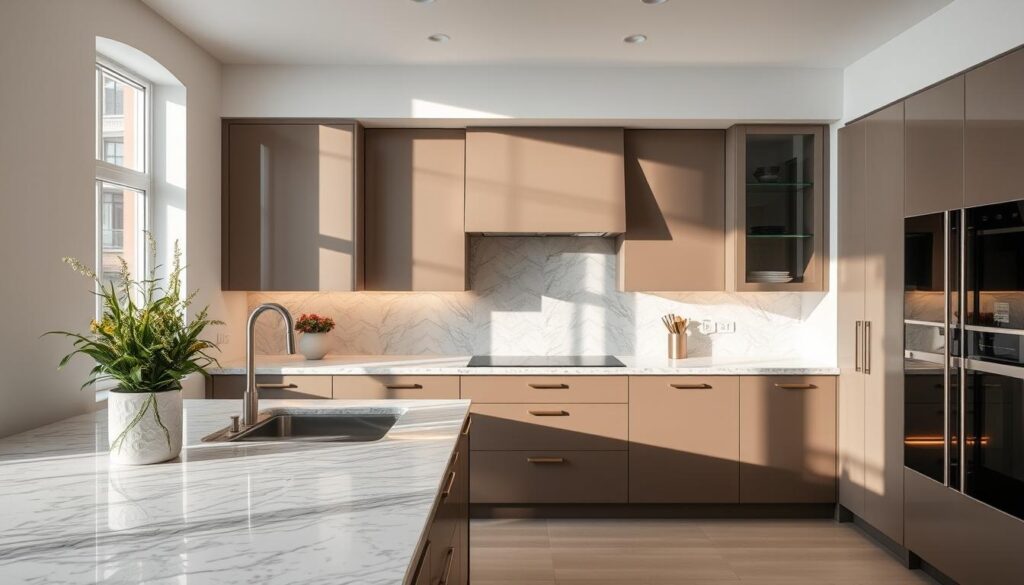
Learn More
Granite countertops are renowned for their durability and timeless appeal. As a natural stone, granite is formed from volcanic activity, resulting in a dense and robust material that can withstand the rigors of daily kitchen use.
Granite is available in a wide range of colors and patterns, from subtle neutrals to bold statements. Its resistance to heat, scratches, and stains makes it an ideal choice for busy kitchens.
Key benefits: durability, heat resistance, aesthetic versatility.
Marble: Elegant Luxury with Character
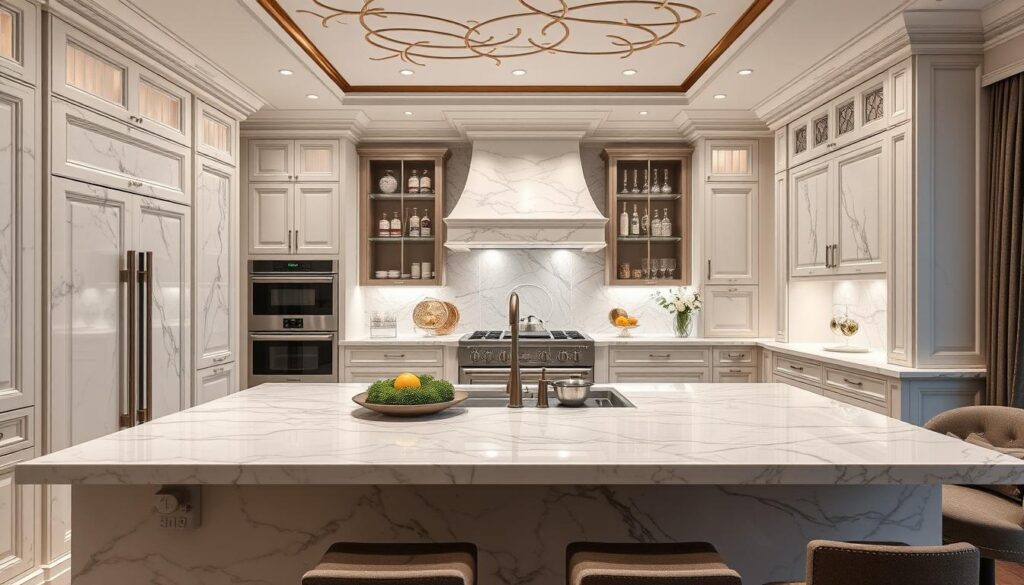
Learn More
Marble countertops exude elegance and sophistication, adding a touch of luxury to any kitchen. This metamorphic rock is prized for its unique veining and color variations.
While marble is softer than granite and more prone to etching, it remains a popular choice for those seeking a high-end look. Regular maintenance is necessary to preserve its beauty.
Marble’s distinctive veining creates a one-of-a-kind appearance that can elevate the aesthetic of any kitchen.
Quartz: Engineered Perfection
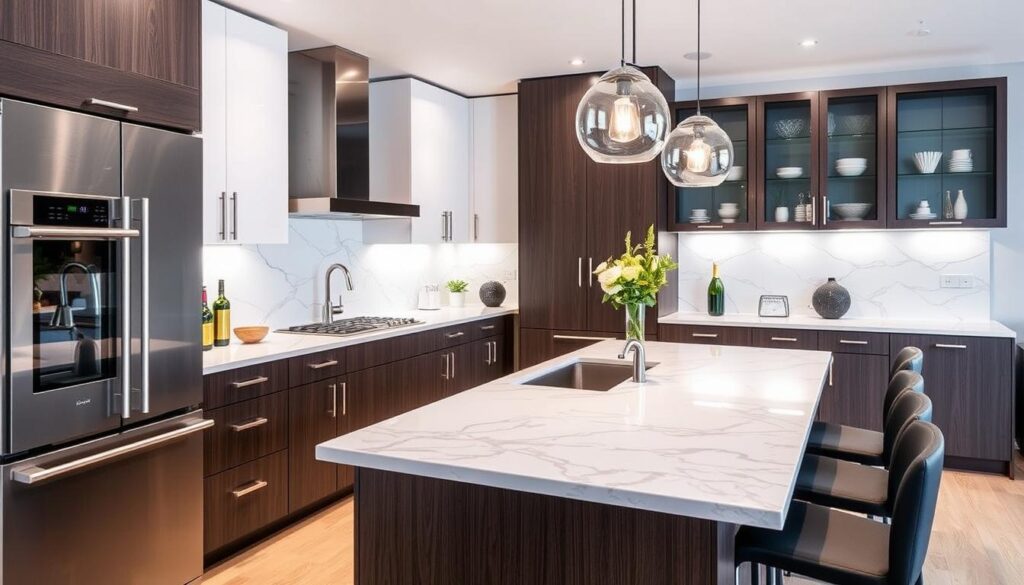
Quartz countertops are engineered to provide a durable and low-maintenance alternative to natural stone. Made from a combination of quartz minerals and resin, these countertops offer exceptional consistency and performance.
Quartz is non-porous, resistant to stains, and requires minimal upkeep. Its engineered nature allows for a wide range of colors and patterns, making it a versatile choice for kitchen design.
Advantages: durability, low maintenance, consistency.
Quartzite: Natural Beauty with Superior Durability
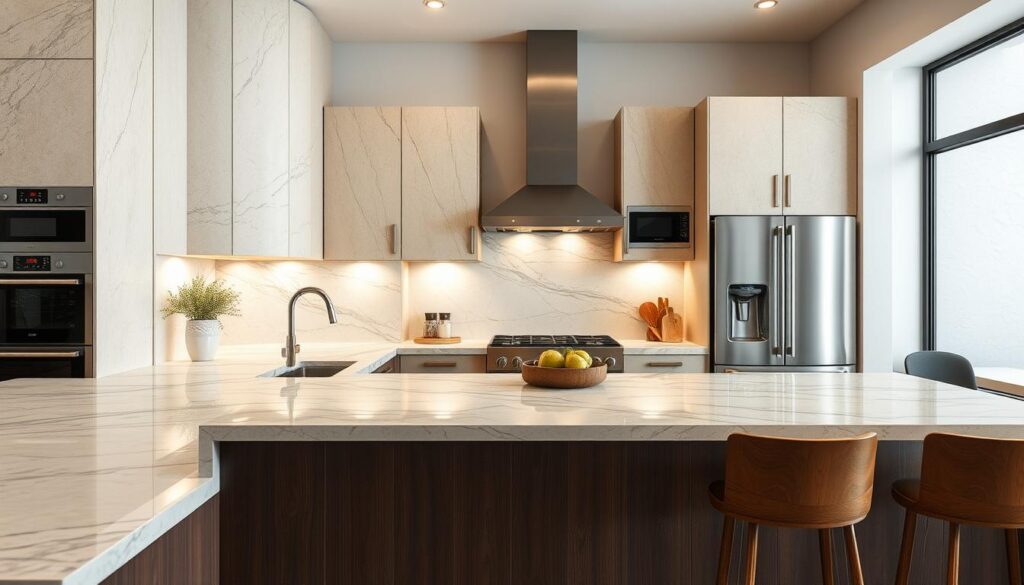
Learn Mor
Quartzite is a natural stone that combines the beauty of marble with the durability of granite. Formed from sandstone and quartz under intense heat and pressure, quartzite is incredibly hard and resistant to scratches and heat.
Its natural beauty, coupled with its superior durability, makes quartzite an attractive option for homeowners seeking a long-lasting countertop solution.
Soapstone: Distinctive Charm and Practicality

Soapstone countertops have gained popularity due to their unique beauty and excellent performance characteristics. This natural stone features a smooth, matte surface with stunning shades of gray.
Soapstone is characterized by its soft, matte finish and tactile quality. It is naturally non-porous, making it resistant to stains and bacteria without requiring sealing treatments.
The material’s excellent heat resistance allows hot pots to be placed directly on the surface without damage. Soapstone typically comes in shades of gray with subtle veining and develops a natural patina over time.
While softer than other stone options, soapstone’s malleability is an advantage as minor damage can be easily sanded out, making it a practical choice for family kitchens.
Stone Countertops for Classic Kitchen Styles
Stone countertops are a staple in classic kitchen styles, offering a blend of tradition and sophistication. Classic kitchens are known for their timeless appeal, and the right countertop can elevate the space, creating a warm and inviting atmosphere.
The choice of stone countertop can significantly impact the overall look and feel of a classic kitchen. Different types of stone offer unique characteristics that can complement various design elements, from cabinetry to flooring.
Traditional Kitchens: Timeless Elegance with Granite and Marble
Traditional kitchens often feature classic elements such as ornate cabinetry and rich color schemes. In these spaces, granite and marble countertops are popular choices due to their timeless elegance and durability.
Granite countertops bring a sense of luxury to traditional kitchens, with their varied patterns and colors adding depth and visual interest. Marble, on the other hand, offers a sophisticated look with its distinctive veining, creating a stunning focal point in the kitchen.
| Stone Type | Characteristics | Ideal Use |
|---|---|---|
| Granite | Durable, varied patterns, resistant to heat and scratches | Traditional kitchens with rich color schemes |
| Marble | Elegant veining, luxurious appearance, requires maintenance | Traditional kitchens with classic, sophisticated designs |
Farmhouse Style: Rustic Charm with Soapstone and Butcher Block Combinations
Farmhouse kitchens are characterized by their rustic charm and warm, inviting atmosphere. Soapstone countertops are a popular choice for these spaces, offering a durable and practical surface that complements the natural materials often used in farmhouse design.
Combining soapstone with butcher block elements can add warmth and texture to the kitchen, creating a cozy and welcoming feel. The contrast between the cool, smooth soapstone and the warm, natural wood of the butcher block can enhance the overall aesthetic of the space.
French Country: Old-World Appeal with Honed Marble and Limestone
French Country kitchens draw inspiration from the rustic elegance of Provence, featuring warm color palettes and natural materials. Honed marble countertops, with their soft, matte finish, are particularly well-suited to this style, offering the beauty of natural stone without the high polish that might feel too formal.
Limestone is another excellent choice for French Country kitchens, providing an authentic old-world surface with subtle fossil markings and warm tones. The patina that develops on these natural stone surfaces over time adds to the authentic character and lived-in charm of the kitchen.
By carefully selecting the right stone countertop, homeowners can create a classic kitchen that exudes warmth, elegance, and timeless appeal.
Stone Countertops for Contemporary Kitchen Designs
In the realm of contemporary kitchen design, stone countertops stand out as a versatile and sophisticated element that elevates the entire space. Contemporary kitchens are characterized by their emphasis on clean lines, minimalism, and high-quality materials, making stone an ideal choice.
Modern Minimalist: Clean Lines with Quartz and Concrete
The modern minimalist kitchen is all about simplicity and functionality. Quartz countertops are particularly well-suited to this aesthetic due to their uniform appearance and durability. The clean lines and minimal veining of quartz complement the sleek cabinetry and appliances typical of modern minimalist kitchens.
When paired with concrete elements, quartz countertops create a harmonious balance between industrial chic and modern sophistication. This combination is not only visually appealing but also highly practical, as both materials are resistant to wear and tear.
Industrial Style: Raw Appeal with Soapstone and Stainless Steel Accents
Industrial-style kitchens celebrate the raw, unfinished look of materials like soapstone and stainless steel. Soapstone countertops bring a touch of natural beauty to the industrial aesthetic, with their unique veining and matte finish adding depth and character to the space.
The combination of soapstone and stainless steel accents creates a striking contrast that is both rugged and refined. This look is perfect for homeowners who want to add an edgy, urban feel to their kitchen while maintaining a connection to natural materials.
Scandinavian Inspired: Light and Airy with White Marble and Quartzite
Scandinavian design principles emphasize light, brightness, and a connection to nature, making white marble and quartzite perfect countertop choices for this aesthetic. The luminous qualities of these materials help to reflect light and create a sense of airiness in the kitchen.
The subtle gray veining in white marble or quartzite adds just enough visual interest and organic character to warm up the clean, minimal lines typical of Scandinavian-inspired kitchens. For a more budget-friendly alternative, white quartz with minimal veining provides a similar look with added durability and lower maintenance requirements.
Transitional and Eclectic Kitchen Styles
The versatility of stone countertops makes them an ideal choice for transitional and eclectic kitchen designs, where blending traditional and modern elements is key. These styles offer homeowners the freedom to experiment with different materials, colors, and patterns, creating a unique kitchen space that reflects their personal taste.
In transitional kitchens, the focus is on balancing classic and contemporary design elements. Stone countertops play a crucial role in achieving this balance, with options like granite and marble offering a timeless appeal, while quartz and quartzite provide a more modern look.
Blending Traditional and Modern with Versatile Stone Options
Transitional kitchens often feature a mix of traditional and modern design elements. Granite countertops are a popular choice for these spaces, as they offer a classic look that can be paired with modern cabinetry and appliances. For a more luxurious feel, marble countertops can add a touch of sophistication and elegance.
The key to successfully blending traditional and modern elements in a transitional kitchen is to choose a stone countertop that complements both styles. For example, a honed granite countertop can provide a warm, traditional feel, while a polished quartz countertop can add a sleek, modern touch.
| Stone Type | Traditional/Modern | Design Impact |
|---|---|---|
| Granite | Traditional | Timeless appeal, versatile |
| Marble | Luxury | Elegant, sophisticated |
| Quartz | Modern | Sleek, durable |
Making Bold Statements with Unique Stone Patterns
Eclectic kitchen designs, on the other hand, offer homeowners the opportunity to make bold statements with their choice of stone countertops. Unique stone patterns and colors can be used to create a focal point in the kitchen, drawing attention to the countertop as a statement piece.
For example, a kitchen featuring a bold, patterned quartzite countertop can create a striking visual impact. Alternatively, a soapstone countertop with its distinctive veining and color variations can add a touch of personality to the space.
Light Colors and Natural Textures
Coastal and beach-inspired kitchen designs often favor light, airy color palettes and natural materials that evoke the feeling of being by the sea. Stone countertops in these kitchens can help to create a bright, sun-filled atmosphere.
White marble countertops with subtle gray or blue veining are a popular choice for upscale coastal kitchens, as they evoke the movement and fluidity of ocean waves. For more casual beach-inspired spaces, light sandy-colored granite or quartzite can create a warm, inviting atmosphere.
The reflective qualities of polished stone surfaces in coastal kitchens help to amplify natural light, further enhancing the bright and airy feel of these spaces.
Practical Considerations When Choosing Stone Countertops
Beyond the visual appeal, stone countertops demand a thoughtful approach to ensure they meet your daily needs and withstand the test of time. The choice of stone countertop is not just about aesthetics; it’s a decision that affects the functionality and value of your home. As you consider various stone options, it’s essential to evaluate their durability, maintenance requirements, and installation process.
Durability Comparison: Which Stone Withstands Daily Use Best
Different types of stone offer varying levels of durability. For instance, granite is renowned for its hardness and resistance to wear, making it an excellent choice for busy kitchens. Marble, while elegant, is softer and more prone to etching and scratching. Quartz, an engineered stone, offers a balance between durability and low maintenance. Understanding the durability of each stone type is crucial in making an informed decision.
| Stone Type | Durability | Maintenance |
|---|---|---|
| Granite | High | Low |
| Marble | Medium | High |
| Quartz | High | Low |
Heat, Scratch, and Stain Resistance: A Practical Guide
Stone countertops vary in their resistance to heat, scratches, and stains. Granite and quartz generally offer high resistance to heat and scratches, while marble is more susceptible to damage from heat and acidic substances. Understanding these characteristics can help you choose a stone that fits your lifestyle. For example, if you frequently cook at high temperatures, a heat-resistant stone like granite might be the best choice.
Maintenance Requirements for Different Stone Types
The maintenance needs of stone countertops differ significantly depending on the type of stone. Porous stones like marble and limestone require regular sealing to prevent stains, while non-porous options like quartz need less maintenance. Granite falls somewhere in between, requiring periodic sealing but being generally more forgiving than marble.
Cost Considerations: Budgeting for Your Stone Countertop
The cost of stone countertops can vary widely based on the type of stone, its quality, and the complexity of the installation. It’s essential to set a budget and consider not just the initial cost but also the long-term value that stone countertops can add to your home. Factors such as the cost of maintenance and potential repairs should also be factored into your budget.
Installation Factors: What to Expect During the Process
Professional installation is strongly recommended for stone countertops due to their weight and the precision required for cutting and fitting. The installation process typically involves template creation, fabrication, and finally, installation, which can take several weeks. It’s crucial to plan for the disruption this process may cause to your kitchen functionality and to ensure that your cabinets can support the weight of the stone.
- Professional installation ensures proper fitting and minimizes the risk of damage to the stone.
- The process involves several steps, from template creation to final installation.
- Proper support structures are essential to prevent damage to your cabinets and countertops.
Color and Pattern Selection for Different Home Styles
When it comes to stone countertops, the variety of colors and patterns available can be both exciting and overwhelming, making the selection process a critical decision. The overall design of the room plays a crucial role, so you can be sure the countertop you love will work seamlessly with the cabinets, flooring, and other design choices.
Light vs. Dark Stone: How to Choose Based on Your Space
The choice between light and dark stone countertops depends significantly on the overall aesthetic you wish to achieve in your kitchen or bathroom. Light stone can make a room appear larger and brighter, while dark stone can add depth and warmth.
For instance, a light-colored countertop can complement dark cabinetry, creating a striking contrast that adds visual interest to the space. Conversely, dark stone paired with light cabinetry can produce a sleek, modern look.
Veining and Pattern Intensity: Making a Statement or Staying Subtle
The veining and pattern intensity of stone countertops can significantly impact the overall style of your space. Dramatic veining can make a bold statement, while subtle patterns can provide a more understated elegance.
For those seeking a contemporary look, bold patterns and dramatic veining can be a great choice. On the other hand, for a more traditional or timeless style, subtle patterns may be more appropriate.
Coordinating Stone Countertops with Cabinetry and Flooring
Successful kitchen design requires a holistic approach to material selection, with stone countertops, cabinetry, and flooring working together to create a cohesive visual story. For timeless coordination, consider the undertones in your stone countertops—warm-toned stones with gold, beige, or cream backgrounds pair naturally with wood cabinetry in similar warm tones.
- Cool-toned stones featuring grays, blues, or greens complement painted cabinetry in whites, grays, and blues, creating a fresh, contemporary palette.
- When working with wood flooring, select stone countertops that either clearly contrast with the floor color or complement it with similar undertones.
- For maximum design flexibility, neutral stones with subtle patterning provide a versatile foundation that can adapt to changing cabinet colors and flooring options over the years.
By carefully considering the color and pattern of your stone countertops and how they coordinate with other elements in your home, you can achieve a harmonious and stylish space that reflects your personal style and enhances the overall value of your home.
Emerging Trends in Stone Countertops
The stone countertop industry is witnessing a surge in innovative trends. As we explore these emerging trends, it becomes clear that homeowners are looking for more than just functionality; they’re seeking a unique design that reflects their personal style.
Dramatic Veining and Bold Patterns
One of the most notable trends is the preference for dramatic veining and bold patterns in stone countertops. Homeowners are drawn to the unique character that these patterns bring to their kitchens, making each countertop a statement piece. For instance, marble and quartzite with pronounced veining are becoming increasingly popular for those looking to add a touch of luxury to their kitchen design.
Matte and Honed Finishes vs. Polished Surfaces
Another trend gaining traction is the shift towards matte and honed finishes. Unlike polished surfaces, these finishes offer a more subtle look that can complement a variety of kitchen styles. The matte finish, in particular, is prized for its ability to hide fingerprints and stains, making it a practical choice for busy kitchens.
Sustainable and Eco-Friendly Stone Options
As concern for the environment grows, so does the demand for sustainable and eco-friendly stone options. Consumers are now more inclined to choose materials that are not only beautiful but also responsibly sourced. This trend is driving innovation in the industry, with companies exploring new ways to reduce the environmental impact of their products.
Mixed Material Countertops: Combining Stone with Wood or Metal
Mixed material countertops represent one of the most distinctive current trends. Designers are strategically combining stone with wood, metal, or concrete to create multi-functional kitchen surfaces. For example, integrating cutting boards made from end-grain wood into stone countertops provides dedicated spaces for food preparation without damaging the stone. Metal inlays, such as stainless steel or copper, are also being used as trivets, drain boards, or decorative elements, adding both functionality and visual interest.
| Material Combination | Benefits | Aesthetic Appeal |
|---|---|---|
| Stone and Wood | Practical for food prep, durable | Warm, inviting look |
| Stone and Metal | Heat-resistant, easy to clean | Modern, sleek appearance |
| Stone and Concrete | Customizable, durable | Industrial chic look |
“The mixed material approach allows homeowners to enjoy the benefits of different surfaces in appropriate zones—heat-resistant stone near cooking areas, wood for food prep, and perhaps metal near sinks.”
By embracing these emerging trends, homeowners can create a kitchen that not only looks stunning but also meets their specific needs and preferences.
Designing with Stone Beyond the Kitchen
While stone countertops are often associated with kitchen design, their versatility and durability make them an excellent choice for various areas of the home. The same qualities that make stone ideal for kitchens—such as durability and aesthetic appeal—also make it suitable for other spaces.
One of the most popular areas to incorporate stone countertops beyond the kitchen is in bathroom vanities. Stone surfaces can elevate the look and feel of a bathroom, providing a luxurious and spa-like atmosphere. The durability of stone is particularly beneficial in bathrooms, where moisture is prevalent.
Bathroom Vanities: Extending Your Style
In bathroom design, stone countertops can be used to create a cohesive look that ties in with the overall style of your home. For instance, a marble countertop can add an element of elegance, while a granite surface can provide a more rustic feel.
Home Bars and Entertainment Areas
Stone countertops are also an excellent choice for home bars and entertainment areas. They offer a durable surface that can withstand the wear and tear of frequent use. Moreover, the aesthetic appeal of stone can enhance the ambiance of these spaces, making them perfect for entertaining guests.
Outdoor Kitchens: Weather-Resistant Stone Options
For outdoor kitchens, it’s essential to choose stone materials that can resist temperature fluctuations, UV exposure, and moisture. Natural granite is one of the most suitable stone options for outdoor use due to its exceptional durability. However, it’s crucial to avoid dark-colored stones in sunny locations as they can become uncomfortably hot. Proper sealing is also critical to protect against harsh weather conditions.
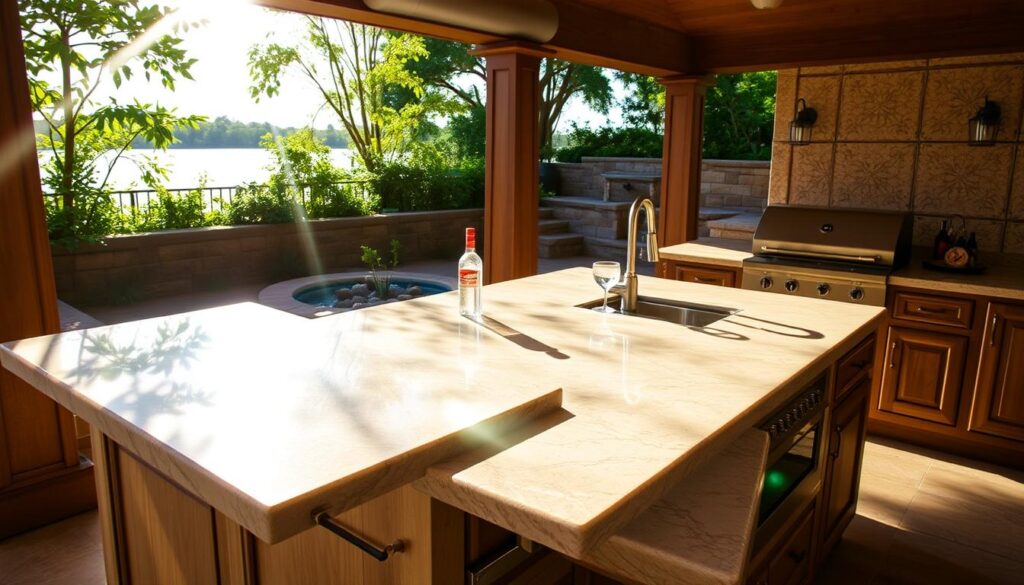
By considering factors such as durability and resistance, homeowners can enjoy the beauty and functionality of stone countertops in various areas of their homes for years to come.
Conclusion: Finding Your Perfect Stone Countertop Match
At The Stone Collection, we understand the importance of selecting a stone countertop that complements your personal taste and kitchen design. With the largest selection of natural and engineered stone products available, we’re confident you’ll find the perfect match for your upcoming kitchen remodel.
Selecting the ideal stone countertops involves balancing aesthetic preferences with practical considerations. For busy households, quartz countertops offer a durable and low-maintenance solution. Those seeking unique character may prefer granite or marble, despite their higher maintenance requirements.
Consider your long-term plans for your home when making your decision. If you’re designing for resale value, neutral stone countertops may be the wisest investment. For your forever home, choose stone that reflects your personal style. By taking the time to research options, visit showrooms, and consider durability and maintenance, you’ll make a choice that enhances your daily experience in the kitchen for years to come.


